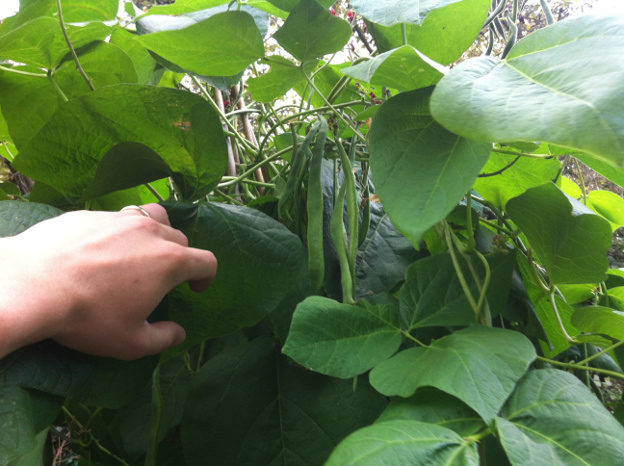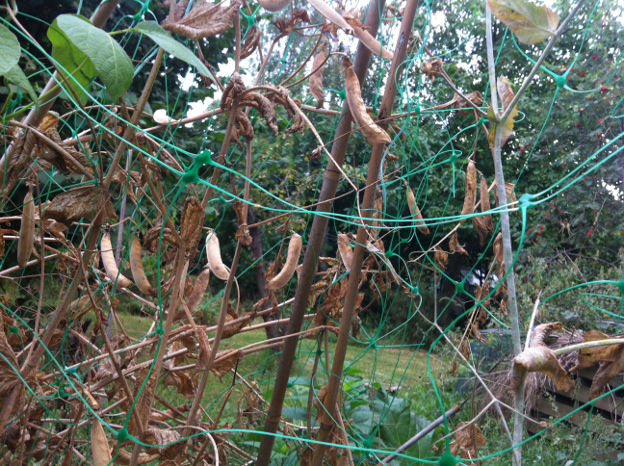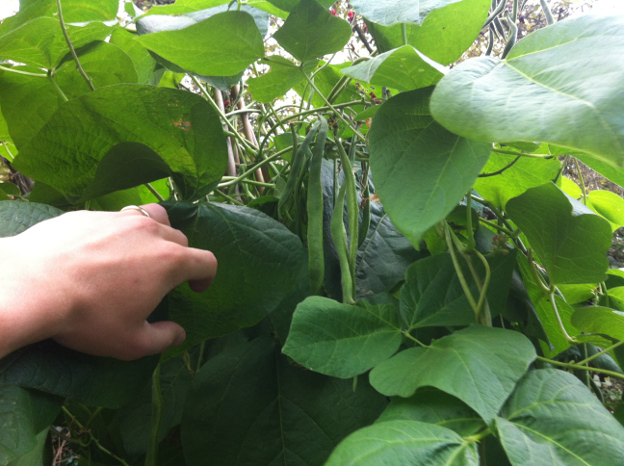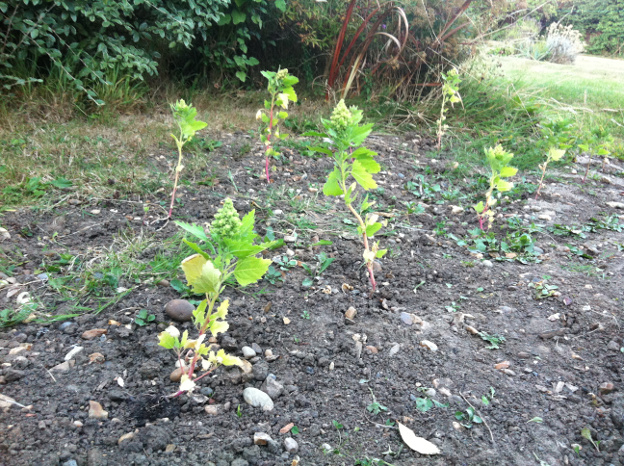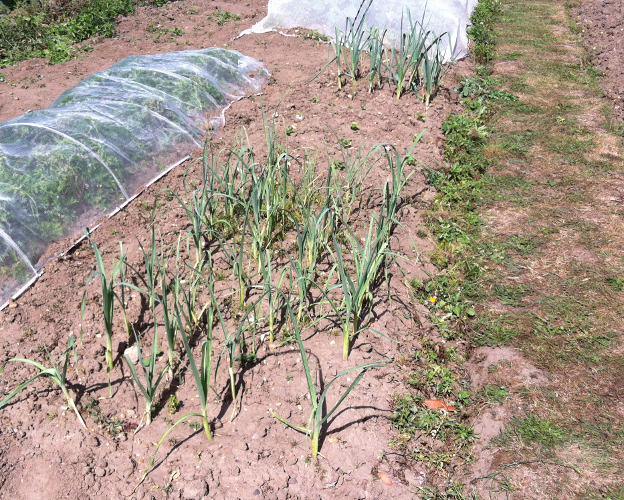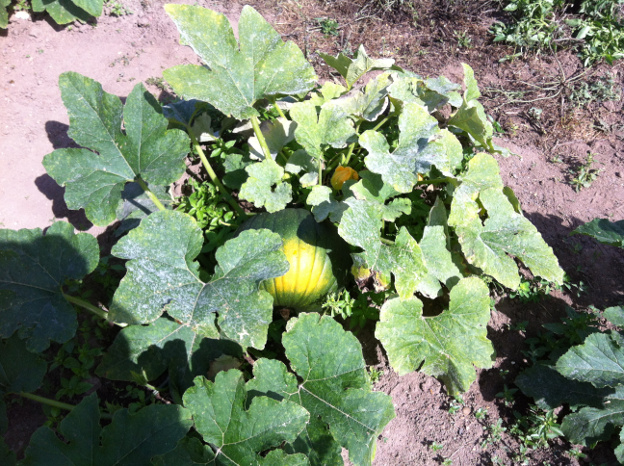We’ve had quite a successful, if a little hectic, month. August carried on where July left off and it has been hot and sunny most days. This has been great for our squashes and courgettes, which have come on leaps and bounds. It has meant we’ve spent a lot of time watering, and so our basic evening routine is either Liz or I water the allotment, and the other waters the garden. These tasks take some time, so what with weeding and cultivating the last of the space at the allotment, it’s been a busy month just keeping things ticking over.
We did get a nice break from watering and weeding as we spent a week away staying with family early in the month. We left the watering of our garden to a neighbour, and the allotment to my dad. Before we left we gave both areas a good weeding and planted out the last of our potted plants. When we returned the diligent watering and sunshine had worked wonders and our plants had transformed!
We suddenly found ourselves snowed under with courgettes, tomatoes, runner beans and pea beans. The plum trees had unfortunately dropped a lot of their fruit and nature had started to ferment its own plum wine on the floor. It’s not been such a bountiful crop of plums this year, and it’s not just ours, I’ve noticed a couple of other local plum trees that were laden with fruit last year, but seemed quite bare this summer. The sun had also started to dry our soup peas and Martock field beans ready for storage. It felt like after our week away we had come back to another garden.

On returning from our holiday we found a couple of courgettes had grown to marrows! Some of our harvest for our return supper.
So that first evening back we harvested a couple of marrows, a courgette, some cucumbers, runner beans and tomatoes and started the exciting challenge of getting the most out of our harvest. This process has continued to date, with courgettes and runner beans appearing on the menu most days.
One meal we enjoyed this month was Hugh Fearnley-Whittingstall’s porotos granados (Chilean squash stew) from the River Cottage Veg Everyday! book book, which is a favourite recipe of ours. But in accordance of what we had available, we substituted the squash for two small courgettes and a marrow, the dried beans for some of last year’s dried pea beans and the French beans for our homegrown runner beans. It worked really well, the sweetcorn and coriander are a winning combination in this recipe, and despite my fears, the squash wasn’t missed.
In the Garden
In the big vegetable patch in the garden, the Jerusalem artichokes have grown absolutely enormous, they tower over me now, they must be at least eight feet tall. In fact most have started to bow under their own weight. Next to them the rhubarb plants have grown rather large, and despite suffering a lot of leaf damage in recent high winds, they are still looking very healthy. It’s strange to think that we grew those from seed not much more than a year ago.
Moving on to the legumes bed, and as already mentioned the Martock field beans and Boddington’s soup peas have reached maturity and started to dry in the sunshine, ready for us to store for the winter months. The runner beans and pea beans are providing us with regular crops and are still producing flowers.
The miscellaneous plot has become quite overgrown, with squashes, courgettes and our cucumber plant sprawling everywhere and our tomato plants growing quite out of control in amongst them. I wish we managed to do a better job with staking the tomatoes. They were staked when they were young, but they have grown a lot since then and I didn’t get around to staking the newer growth before we went away.
I should really have addressed the issue that first week back from our holiday, but I didn’t and now they have grown rather crooked. I have since tied the new growth to the canes that the lower sections are staked to, but this has just left the crooked plants with a willow-like hanging habit. But they are producing crops, which is of course the most important thing.
The remainder of the bed is dedicated half to brassicas and half to alliums and roots. The alliums and roots section has actually played host to our potted trees this year, as there is more sun there than where they stayed last year. Also the space was going spare as we planted our earliest alliums and roots into what was last year’s pumpkin patch, and then got the allotment before we planted the rest. The only alliums we have growing in the large vegetable bed is a row of leeks which we couldn’t fit in the pumpkin patch or the allotment.
The brassicas have had mixed success in the large vegetable patch. We’ve lost quite a few to pests, but the survivors are looking strong. The leeks are doing fairly well. They are a variety that we’re trying for the first time this year. The variety is named ‘giant Bulgarian’, and they are supposed to grow large and thick. They certainly look promising, filling out impressively very quickly. We also have a lot of these at the allotment and they are filling out nicely too.
Moving on to what was the pumpkin patch last year (we really do need a name for this bed), here we planted potatoes, oca, leeks, celeriacs and quinoa. The potato tops have died back and are ready to be lifted. The oca are looking healthy and they really have been a hassle-free crop so far.
My particular favourite oca plant is one of the ones that snapped from the tuber as we were sowing them. We then left this in a glass of water and it formed roots. We planted this out, but shortly afterwards the bed flooded and it looked as though it may have died. With no energy stored in a tuber, I feared it wouldn’t survive. However, it’s now looking strong and we’ll be interested to see how the tuber from this plant compares to those of the other plants which had tubers when we sowed them.
The celeriacs in this bed are doing well. That is the ones that survived. I detailed in last month’s report how we lost many to pests. But those that survived are doing well. The leeks are thriving in this bed too. We’re growing two varieties this year, the variety giant Bulgarian, which I described earlier, and ‘Monstrueux de Carentan’, a French variety for autumn use. Apparently they grow quite thick, but are not particularly winter hardy.

The survivors – celeriacs growing in our garden. These are looking very healthy – much more established than our others at the allotment.
I’m not sure what to make of the quinoa plants. They’re still very small. And they don’t look too healthy either. They also look like they are forming seed heads. I’d be happy with this, but in the photos I’ve seen of them of growing, even in the UK, they grow very large. Our’s are tiny! We’re still excited to see what the outcome of our venture into grains will be.
At the Allotment
The allotment is really taking shape now. The brassicas are looking healthy and the scaffolding netting that covers them appears to have kept off the cabbage white butterflies. In the remaining area of that bed that the net didn’t cover, we’ve been sowing radishes, as technically these are brassicas, and they don’t take long to reach maturity.
The alliums/roots bed is looking good too. The carrots are looking healthy, or at least their tops are. The celeriacs are still alive, but the tops haven’t grown much since we planted them out in their paper pots. This is the same method we used in the garden, and the ones there are looking much more established, although they have been in the ground longer. I’m hoping that the lack of growth above the soil means that they’re putting their energy into forming swollen roots beneath the surface. Here’s hoping!
Before we went away I sowed some beetroot seeds in a spare patch. The germination rate wasn’t great, but we do have a few that have come up. I’ve since filled in the gaps with more seeds. The leeks are doing well too. We’ve got more Bulgarian giants here, as well as a few of unknown variety that were donated by a fellow plot-holder a couple of rows over. They were quite established in a holding bed before we transplanted them to our plot and they are almost ready for use.
The miscellaneous bed has really come to life. The big story here is the curcubits. We’ve had courgettes aplenty in the short time that we’ve had this allotment. We’ve also got a couple of pumpkins on their way, one large and one from a dwarf plant of the variety ‘baby bear’. We’ve also had a couple of patty pans and a few tomatoes.
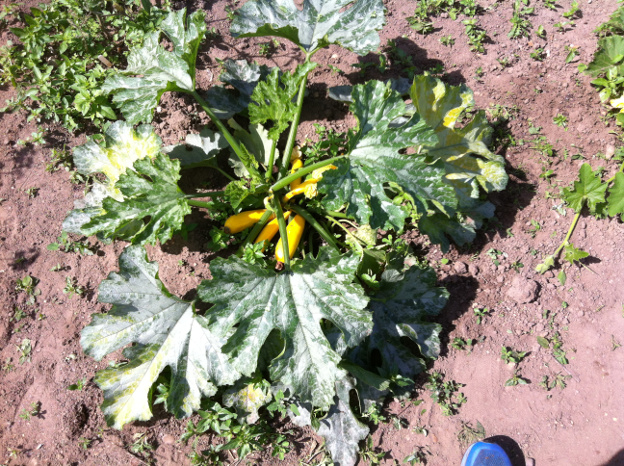
A decent crop of courgettes – digging that manure from the stables seems to have been worth the effort!
The tomatoes have been a little disappointing though. Upon receiving the news that we could have an allotment, we had a lot of young tomato plants donated to us by friends and family who had sowed surplus plants. But many of these were rather pot-bound by the time we got plant them out, and most aren’t really thriving, but they are producing tomatoes.
When we were preparing the allotment, we found potatoes growing. We took a few home for the pot, and the remainder I replanted in the miscellaneous bed. I’d not heard of transplanting potatoes before, but I couldn’t bring myself to compost them. Those that I replanted are really doing quite well, as the following photo shows.

Potatoes that we replanted at the allotment. Being dug up doesn’t appear to have done them any harm!
Finally, we tried a new crop this year which we haven’t mentioned up until now. We planted a couple of asparagus pea plants in the miscellaneous bed at the allotment. We’ve never tried these before, so we know little about them. The plants haven’t grown at all as expected, they have really sprawled. But they have started to produce a crop, which can be seen in the photo below. They look almost cactus-like.
We’re yet to try any, but we will be sure to post about them when we do. That concludes this month’s growing report. Thanks for reading, and check back for more posts very soon.


